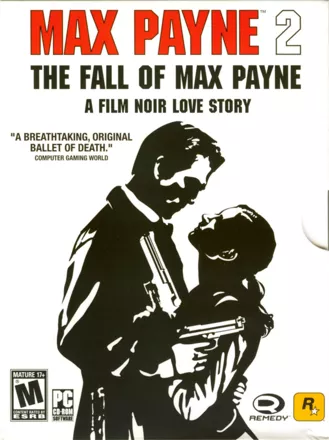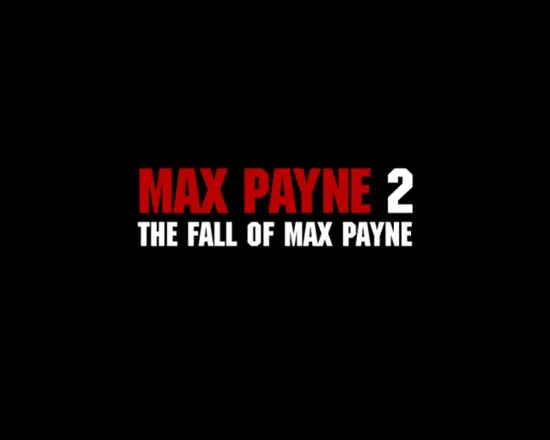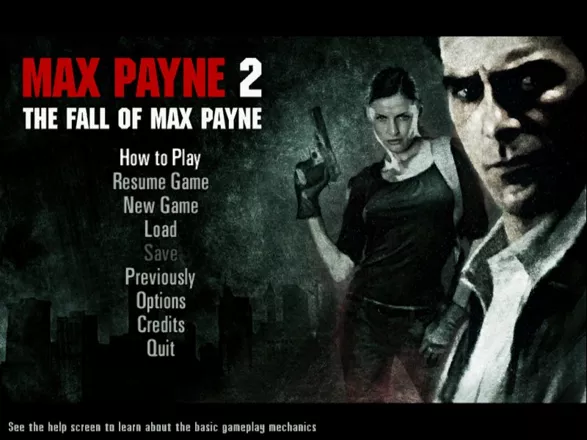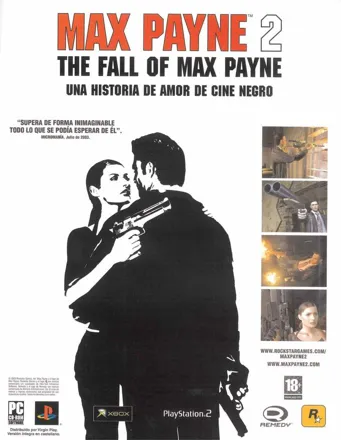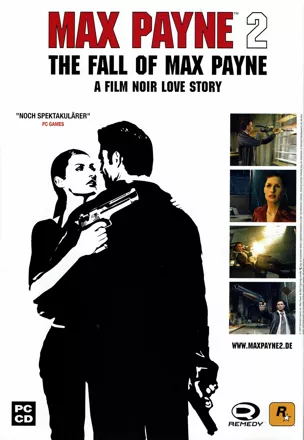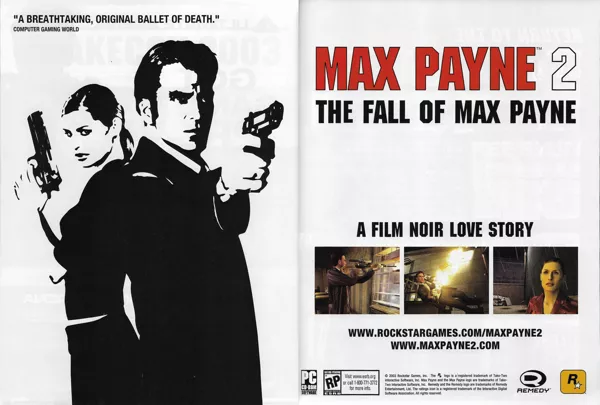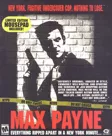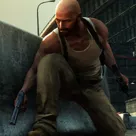Max Payne 2: The Fall of Max Payne
Description official descriptions
Two years have passed since Max Payne first embarked on his desperate quest for revenge. Returning to his former position as a detective in the New York City Police Department, Max is assigned to investigate a series of murders carried out by group of contract killers known as the Cleaners. Unexpectedly, Max encounters the enigmatic Mona Sax, whom he assumed dead. People from his past begin to return one by one, and Max gradually realizes that he did not know everything about the mysterious Circle and those who were involved in the murder of his family. Somebody out there is trying to kill Max, and he must find the answers before they succeed.
Max Payne 2: The Fall of Max Payne is a direct sequel to Max Payne. The game is very similar to its predecessor in gameplay concept and presentation, bringing back noir detective atmosphere, cinematic John Woo-style action, and cutscenes shaped like comic book panels.
The game is built on the same engine as the predecessor, with several additional special effects and enhancements, such as dynamic shadows and lighting, cubic mapped reflections, and high resolution textures. The Havok engine with ragdoll physics is used to enhance the interactivity with the game world: objects can be moved and destroyed, physically responding to the actions of the player character and opponents.
A new feature in the sequel is the possibility to use secondary weapons alongside regulars guns, namely melee strikes, grenades and Molotov cocktails. Certain characters will join Max and fight on his side from time to time. The player also controls Mona Sax during a few stages. The Bullet Time feature from the previous game has been upgraded to version 2.0, in which Max's speed in bullet time increases as he gets more kills consecutively.
During the first playthrough the game only offers one difficulty level. If the player struggles to succeed, the game will automatically lower the difficulty, reducing the effectiveness of enemy fire and increasing the amount of painkillers. Additional difficulty levels are unlocked when the player completes the game, as well as two new modes: New York Minute and Dead Man Walking. The first awards the player with a score for completing a level as quickly as possible, while the second has Max fighting endlessly respawning enemies.
Spellings
- 英雄本色2:马克思配恩之秋 - Simplified Chinese spelling
Groups +
Screenshots
Promos
Videos
Add Trailer or Gameplay Video +1 point
See any errors or missing info for this game?
You can submit a correction, contribute trivia, add to a game group, add a related site or alternate title.
Credits (Windows version)
324 People (272 developers, 52 thanks) · View all
| Project Lead | |
| Lead Game Design | |
| Written By | |
| Game Programming Lead | |
| Technology Programming Lead | |
| Graphic Design Lead | |
| Art Direction | |
| Programming | |
| Additional Programming | |
| Level Design - Gameplay | |
| Level Design - Art | |
| Additional Level Design | |
| Modeling | |
| Character Animation | |
| Texture Art | |
| [ full credits ] | |
Reviews
Critics
Average score: 86% (based on 59 ratings)
Players
Average score: 4.0 out of 5 (based on 263 ratings with 12 reviews)
More than I hoped it would be.
The Good
Max Payne 2 made three large improvements over the first game in the series. Here is a quick overview:
First: The graphics engine was greatly enhanced, and a physics system was added - not only can Max knock over some pieces of furniture or other small items when he runs into them, but there are some amusing physical chain-reactions that can occur in some circumstances. For example, picture two dozen cafeteria-style chairs piled on top of an explosive ammo crate in the corner of a room. C'mon, you know you wanna toss a grenade in there and watch the result.
Also, the game's textures, especially the models and textures used for the stars of the show (Max and Mona) look gorgeous. Additionally, a number of visual effects were added - in Bullet Time, the screen becomes washed out and all of the colors become muted, and motion-blur effects are used liberally (but not too much). Even with a low-end videocard, you can get a very enjoyable visual experience. I first played this game with a GeForce4 MX, and had no significant graphics problems. Even Max's nightmare/hallucination sequences are severely distorted, visually, adding greatly to the experience.
Second: Bullet-Time (BT) was tweaked somewhat. You still have the familiar hourglass time-limit, but now it regenerates slowly over time. Also, shoot-dodging does not use up your BT reservoir anymore. And most importantly, when you enter BulletTime directly, and start racking up kills, Max moves faster and faster (or, to be more precise, everything else slows down relative to Max). As you gain "levels" in Bullet Time, the screen and sound effects get more and more washed-out, muted, and... "focused". Get enough kills, and Max finds himself running around in a blurred, sepia-toned "tunnel-vision land", with his enemies standing nearly (but not quite) motionless. Naturally, the BT "levels" are temporary in nature, so Max needs to rack up a good number of kills, fairly quickly, to hit his maximum level. They fade away over time as Max "calms down".
So with Bullet Time 2.0, the developers eliminated a large part of Max Payne 1's challenge (limited Bullet Time), in order to make the game more "fun". It certainly succeeds; it's very easy to get immersed in this game when Max is fully "in the zone". And assuming you can find a safe spot to rest for a minute or two, you'll always be able to enter the next battle with a full BT hourglass.
Third: Scripted sequences? Yeah, we got scripted sequences. Max Payne 2 has so many NPC and plot-advancement scripts, it makes Half-Life look dull by comparison. The first game had a few, here and there, but in MP2, there's almost always something going on.
Now, about the actual game itself.
The story in this game rocked. In some ways, it seems to actually be more story-oriented than action-oriented. But I love a good helping of Plot(tm) with my shooters, so it's all good. The actual environment is great, too - present in MP2 are the television shows from the first game, but you run into them at more frequent intervals. During a lull in combat, it's nice to relax and watch the adventures of Captain Baseballbat Boy, follow the story of Lords and Ladies, or catch up on Address Unknown. There is also a new "TV show", Dick Justice, which is seemingly a parody of Shaft combined with Max Payne 1. Always good for amusement.
The level design, with one exception, was excellent. The levels tend to be very large, and perhaps a little repetative at times, but there's enough variety that it's difficult to become bored and lose interest. It's even difficult to get lost in some of these large levels, which is also a plus. The levels include (but aren't limited to) a large building under construction (plenty of scaffolds to play around on), a surreal funhouse (based on Address Unknown), a burning building, a mansion, Max's apartment building, even the NYPD station Max works at. All of these environments have a ton of detail, and you sometimes find yourself revisiting them later in the game (except the second time around, they're very, very different, due to various Plot Activities(tm) that have occurred.)
Another neat plot device is that after playing as Max for a while, the perspective switches to Mona, and you guide her through the game for a while (don't worry; Mona can also use Bullet Time). The neat part is, Mona's stories take place roughly at the same time as Max's. This happens a few times during the game, and Mona typically enters a level from the "opposite side" as Max. So effectively, when your perspective switches to Mona, time reverses roughly one hour, and you play through the level again - just from the other end. I'm sure I'm not explaining it very well, but as a plot and character-development device, it works very well.
Ordinarily I hate "love stories", which Max Payne 2 certainly tries to be. But I must admit, it pulls it off very, very well.
I should also mention that the Max Payne series has a huge, active mod community. The level-design tools were released to the public, just like with the first game. Also, MP2 has a few different difficulty levels, just like the first game. Except if you complete the game at the hardest difficulty level, you apparently get a different, "happier" ending. I've never gotten there, myself - almost, but not quite. But still, even if you complete the game once, you unlock the "Dead Man Walking" levels. These are small, self-contained levels, totally unrelated to the plot, where enemies continually spawn in at shorter and shorter intervals. Your survival time is your "score" in these levels, and they're great for a few minutes of mindless action. How long can you last?
The Bad
I mentioned an "exception" above, in regards to level design. There is, apparently, a flaw in the level-design tool (or perhaps in the graphics engine itself). If your objects don't line up just right in a given map, if you don't cross every single T and dot every I, a significant number of errors are introduced, and the game goes berzerk trying to perform all of the calculations it needs to do. It doesn't corrupt the display, and it doesn't crash or anything, it just becomes VERY, VERY SLOW. Like, we're talking 1 frame every two seconds. Granted, this only happened to me once in the entire game, and only in one particular room looking in one particular direction (at a pile of junk and debris), and it's extremely easy for me to reproduce; it happens every time. But still, there's no real way around this problem, and you've simply got to trudge through it. I'm sure anyone in the mod community who has used the level-editing tools has run into this at least once in their own maps.
Also, I wish the Dead Man Walking mode was unlocked at the very start.
But you know, other than that, I don't really have any complaints. Except perhaps that the game was too short. It felt a lot shorter than the first game, somehow.
The Bottom Line
I'm sure that fans of Max Payne 1 would love this game. In fact, it even seems to stand alone well enough, which can be rare for a sequel. You don't need to be familiar with the first game to enjoy this chapter, but it helps - you'd probably miss a lot of the in-jokes and references otherwise.
Windows · by Dave Schenet (134) · 2004
Is the glass half empty or is it half full?
The Good
INTRODUCTION: Still going down.
I am Max Payne.
My wife and daughter were murdered. It had something to do with the designer drug "V".
With nothing to lose, I went after the mafia during the worst snow storm in a century.
The pursuit threw me against a secret conspiracy involving people behind the government, behind everything. I was In over my head.
In the end, my enemy turned out to have a name: Nicole Horne.
I killed her, and I gave myself up to the police. That same night, the snow storm stopped.
Horne's enemies took care of it all. I came out clean, I was even turned into a hero, the brave cop who single-handedly got rid of the worst NY mafia family, along with the threat of "V".
I went back to the NYPD.
I lied to myself that it was over.
I was still alive, my loved ones were still dead.
It wasn't over.
Max Payne wakes up in a hospital, wounded beyond the point a human body could logically sustain. He steps out of the bed, he knows his life's in danger, even here. Stumbling through the rooms, with his typical narrative greatness he comments "You can't run away from the past. You'll end up running in circles."
It all started as a normal NYPD detective night. Max took a call to attend an apparent hostage situation at a certain downtown warehouse. It wasn't his kind of thing, but he knew the owner of the warehouse: Vladimir Lev. The russian smooth operator, the head of the russian mob who helped him in his crusade against Nicole Horne.
Max finds something dirty going on in the warehouse. Right when backup is arriving, he catches a glimpse of a ghost from his past: Mona Sax, the beautiful hired killer that was also behind Horne. But... wasn't she dead? Max was sure he saw her die.
Or did he?...
MAX PAYNE 2: THE FALL OF MAX PAYNE is the sequel to the much-acclaimed MAX PAYNE (duh), the third-person perspective shooter with stylish and grim storytelling full of film-noir dialogue, and the gameplay-candy that turned the dream true for fans of the movie The Matrix: the slow-motion red-hot gun-fighting system known as Bullet-Time.
VISUAL EFFECTS AND PHYSICS: The ultimate mod.
When I finished the first MAX PAYNE, I liked it so much I went on to try some of its famous mods. That game has been virtually re-written a hundred times by fans, giving us the possibility to re-play it as a samurai, a jedi knight, a class-B kung-fu movie hero, and a Blade Runner, among others.
MAX PAYNE 2 feels, above all, like another mod. The best of them all, of course, since its programmers are the programmers of the first game. The game engine is the same MAX-FX engine used in the first game, which means the gameplay feels the same in several aspects. While recycling a 3-year old game engine could be a reason for some to raise an eyebrow, some have also said: if it ain't broken, why fix it?
The engine HAS been re-worked, and it tells.
First, the textures: the first game had amazing textures for scenarios and pretty good textures for character models, but you could see some serious blurs whenever the camera zoomed in, specially in character faces. This game, on the other hand, has uncanny extremely detailed textures for both scenarios and characters —no more blurs, not even in the closest-close-ups.
In the special effects dept, as one might expect from any self-respected current-generation game, we have eye candy of all the flavors: dynamic shadows work, lighting, reflections, weather, particles...
However, none of the above can be compared to the vedette of the game: the physics.
MAX PAYNE 2 licensed the Havok 2.0 physics engine, and the thing is a masterpiece. The gameworld is as interactive as it gets. Everything in the scenario is alive. Boxes, staircases, chairs, tables, brooms, buckets —everything reacts to contact. You bump on a pile of objects and the pile falls down making a mess, you can push a box on a person's heads and knock him out, a falling body can crash against a table scattering everything that was on it...
The game also uses a beautiful ragdoll effect for the animation of dying bodies, meaning that you won't ever see the same death twice, or that you can keep shooting a dead body and it will shake accordingly, depending WHERE you hit it.
As players of the first game know, Max hasn't had a good sleep for years. The moment he closes his eyes he lives a nightmare, and the game continues inside it.
In this game, the nightmares have changed in two key aspects: first, they are more like an interactive cutscene, with no platforming whatsoever —in fact there's no way to die at all while dreaming; and second, here is where the developers put the greatest amount of eye-candy. The dreams have been STUFFED with fancy special effects, eerie lighting, volumetric fog, walls bending, motion blur... you have got to see it.
Also, the concept of these dreams makes them MUCH more believable than before, the locations change its shape suddenly, Max gets to see himself in different situations, other characters show up and speak to him... it all feels like a real nightmare alright.
Now, how much do you think this all can cost?
Well think again, Jack.
One of the most amazing features of the game is the scalability it offers: you can turn on so many effects that your new 300-buck super video chip will reach temperatures high enough as to fry eggs on the heatsink, but you can also turn stuff off to the point the game runs in a pocket calculator!
...
OK, maybe I got a little carried away, but the fact is, I have a friend who managed to run this game with a 600MHz PIII CPU and a GeForce2 video card, which IS some achievement, specially since the game itself recommends at least 1GHz CPU and a fully-DirectX8-compliant video card.
GAMEPLAY: What Matrix?
This sub-title should need no further explanation, but I like to write, and if you don't like reading long-ranting reviews, you probably never reached this point, so here we go.
The first MAX PAYNE was praised by several aspects, but there were two MAJOR gameplay-candy features we all loved: Shootdodging and Bullet-Time.
Shootdodging consists exactly in that: by the pressing of a magic key, you take a sideways dive, the action is slightly slowed down, and until you hit the floor you keep shooting and moving the camera, thus aiming in different directions on the fly :P
The Shootdodging in MAX PAYNE 2 has been slightly enhanced. In the first game, once you landed, Max would automatically stand up, which more often than not meant a few holes through his fancy leather jacket. Here, he keeps shooting until you release the fire button.
This is much more useful than you can imagine by reading this, specially if you played the first game.
As for Bullet-Time... well, everyone and his dog knows what this is. If you haven't seen any of The Matrix movies, you probably saw Charlie's Angels, or ANY other action movie made after 1999. If not, the thing has already been used for TV commercials, music videos, and high-budget porn. You SAW it. Lots of times: When an action scene begins, a slow-motion effect takes over, making it all look dramatic and pretty fancy, with camera pans and zooms. MAX PAYNE was the first videogame to get it right, several years before an official The Matrix game was even announced, and even today it stands as the unbeaten king of Bullet-Time. Not even the official ENTER THE MATRIX can compete with it.
MAX PAYNE 2 sports Bullet-Time 2.0, with an interesting twist. First, for eye-candy's sake, the whole scene suddenly changes colors and brightness levels, and the slow motion is decorated with motion blur, an effect that's becoming more and more popular nowadays (ironically, several years after 3dfx, the first company to bring it up, imploded); second, the real thing: at first the speed difference is not much noticeable. As you kill enemies in this mode, you gain more time for the effect to last, and the scene slows down more and more, while Max maintains his speed.
Again, this is something that has to be experienced to fully understand it.
Moving on, the difficulty deserves a small note, for I feel it's been very nicely balanced. I readed that the game configures the difficulty on the fly, depending on the player's skills —whether or not this is the case, the thing is, I remember using Shootdodging in the first game only as a fancy feature to make the game more fun, and not using Bullet-Time AT ALL. In this game, on the other hand, Shootdodging will be a real life-saver several times, while a good use of Bullet-Time is MANDATORY in crowded firefights.
Other interesting gameplay additions include a few new weapons, the possibility to interact with some friendly NPCs (some of whom will even join us fighting the bad guys), and switching between playable characters at a few parts of the game.
STORYTELLING: Watch more TV!
The storyline has been a little more worked on this time around, but it still doesn't stand as a truly remarkable aspect. It does however offer a few plot twists (mostly related to the reappearance and band-switching of characters from the previous game), a few brilliant tension-building scenes which reach surprising conclusions, and a somewhat more intriguing storytelling.
Above all, I found Max's classic "film noir" quotes much more attractive in this game. If you liked his phrases the last time, prepare to meet a truly inspired Max.
Like it also happened in the first game, there is a lot of storytelling-support through the use of paralell devices, such as idle conversation between NPCs, TV shows, different types of advertising, phone messages, et cetera. Provided you have the patience to pay attention to all those kinds of things, you'll find several smart winks to the story, to the first game, and to several TV and cinema classics. In this dept, there are at least three much-welcomed returns: the corny soap opera "Lords And Ladies", the morbidly hilarious "Captain Baseball-Bat Boy" (now a cartoon), and my favorite: the grim-atmosphere TV show "Address Unknown", which mixes the likes of Twin Peaks and The Twilight Zone —this time playing a MAJOR part in the game.
REPLAYABILITY: A masochist's paradise.
Finally, another aspect that has been nicely enhanced from the first game is the replayability factor.
The amount of special gameplay modes unlocked after the first playthrough has grown up considerably. This time not only we unlock progressively harder difficulty levels and the famous "New York Minute" mode (which gives you a time limit to complete each stage), but there are also a few new modes.
The most promising is "Dead Man Walking". In this mode, you WILL die, insanely outnumbered by enemies, there's no solution for that. The only question is, how long will you last before that happens?
Talk about an enticing challenge...
The Bad
CHARACTER MODELS: 2001 is already done, people...
Like I said, MAX PAYNE 2 is using a modified version of the engine from the first game. Almost every bad thing that can be said about this game is related to the fact that you don't really feel it like a sequel, but more like a mod.
The game engine IS a good engine, and they managed to pack a truckload of serious enhancements in it, but some limitations are still noticeable.
The most annoying problem to my eye is the character models. Despite all the bump-mapping, the hi-res textures, the pixel shading, and what all not; the models look outdated for the current time. On top of that, some of the enhancements don't fit the engine correctly: I don't know if it's a problem of my particular video card or if it's the game itself, but once you turn the detailed shaders on, some details look exaggeratedly detailed. The characters skin for example, look shiny, as if they were made of leather. Or if they had some hardcore baby-oil bath.
Another issue I found annoying is the newly-presented lip-synch. First, this is the stone-age old muppet-mouth-like lip-synch, which is unacceptable in a time when the hardware Vertex Shaders allow marvels in facial expressions as we saw in SOUL REAVER 2, or the second and third SILENT HILL games. Second, and even worse, most of the times the lip-synch doesn't work properly, and sometimes it doesn't even work —at all. You hear the voice, but the mouth doesn't move.
GAMEPLAY: Always in a rush.
Even though the gameplay in MAX PAYNE 2 easily count among the smoothest you can find out there, there are a few issues to note.
First, I found the camera strangely troublesome, much more than I ever did in the first game —Max's own body would get in the way, not giving me a proper vision of the enemies I was fighting. This of course does happen every now and then in any third-person perspective action game, but I have the impression that it happened a few too many times in this game.
Another thing I found annoying is that Max, like in the first game, is always in a rush.
This game features a few calmed-down stages, throughout which one could pay some attention to the details, and catch a breath after all the pulse-pounding gunfight. For example, there's a stage which starts in the NYPD building, where you'll need to have a few conversations before the action begins. This kind of stages could be navigated slowly, calmed, in a normal-walking pace... if only Max was able to do anything besides desperately running.
I don't know whether our good NYPD detective is drinking too much coffee, or his unfortunate life took a serious toll on his nerves, but the thing is, Max can not walk. In the enclosed halls of the NYPD precint, you'll feel like a moron, all the time bumping on stuff because Max crosses a room before the door even got to close.
Of course, in action sequences this leaves any kind of surprise attack or sneaking from behind well out of the picture.
Even though I found the NPCs tagging along Max a great idea, this won't happen more than three times throughout the whole game, and these NPCs won't perform as well as one could expect. They will require a lot of protection from your side, and when you least expect it, you'll find them stone-cold, laying on the floor.
Finally, the game is, as its predecessor, a 100% linear ride. No exploring, no secret areas, no adventuring, no interactive conversations... nothing out of the good old if it moves, fill it all full of lead. Of course, some may think this fits in the good. I don't.
You know, tastes.
STORYLINE: The easy cure.
I said the storytelling was pretty good, but the storyline itself is pretty weak.
When you start writing a sequel, there are two easy ways to do it that jump in your head at once: either you recycle the exact same structure for the story, making a number of changes as to disguise the swindle a little (think SILENT HILL 3 or METAL GEAR SOLID 2), or you take whoever character survived the first story and make the sequel based on them. MAX PAYNE 2 relies on this last resource, it takes the few survivors from the first game, takes a few points that might be interpreted as well-concealed loose ends or simple plot holes, and writes a film noir love story, in which the two main characters run against the clock trying to uncover who is the survivor from the first game who wants them dead. For one thing, MAX PAYNE left so few survivors that you pretty much have a 50% of chance to figure who the bad guy is, alone with the tossing of a coin.
Once again, the story makes the game feel like a very good mod to the first game, and not a real full-scale sequel.
Even the storytelling-enhancing devices I praised so much are recycled from the first game, and while they MAKE this story very enjoyable, they also add to this general impression.
The Bottom Line
Is the glass half empty or is it half full? In this case it's the same as asking: is this a low-profile sequel or is it the ultimate mod?
MAX PAYNE 2 is basically more of the same, but every single thing that was good in the first game is at least as good in the sequel. In fact, more often than not, it's WAY better.
So, in the end, it comes down to this: if you enjoyed MAX PAYNE, chances are you're gonna LOVE MAX PAYNE 2.
Now, if you didn't like MAX PAYNE... well, I don't even know what you're doing in this website.
Windows · by Slug Camargo (583) · 2003
The Good
In 2001 Remedy Entertainment gave us Max Payne. A story about a man who was committed of a crime he did not commit, and thus sends sweet vengeance upon the entire New York crime syndicate.
Now a couple of years on the Fall of Max Payne continues this story. Is this just a classy revamp of what we've already seen or a bit more?
STORY Taking straight off from where Max Payne 1 left off - we continue the story of Max Payne. Just fresh from managing to get away with killing pretty much the whole of the New York underground - Max has left the DEA and has joined back with the NYPD.
While investigating a strange group of cleaners - Max runs into a problem - Mona Sax.
While this story purposely takes off many film Noir ideas and themes - it's still quite well done - it flows on smoothly and it's quite engaging.
MENU Very much the same as the last Max Payne - a image of Max and Mona against some rainy backdrop that has had many photoshop filters slapped onto it. Even the loading bar is the same - have I been here before?
CONTROLS Well - they're exactly the same as from the first game. Left Mb you fire, Right Mb for the very funky bullet time WASD for moving and so on. The only little difference is that grenades, melee weapons and molo cocktails are now on a sub class of their own - meaning you just need to select what one you want - then hit F to throw them. I would have preferred a separate key for melee - as it's so fun whacking things.
GRAPHICS Running on a Geforce 2 TI - I had visions of trying to play the Max Payne 1 demo on my aging Celeron 400 with the TNT 2 (it actually ran) But no - what ever stunning optimization tricks the developers used - they used very well. I experienced very little slowdown in the game with everything (bar shadows) on full. I was unable to check out the pretty pixel shaders ...but still.
The texturing along deserves to win an award - I have never seen our world represented in a hyperrealistic way as this game has presented it - it was very scary. Also things like plastic has been very well textured. On a higher system I'd imagine the textures would be a bit better. But nevertheless I was constantly blown away by their very well done application of textures for the game.
The game character models have been greatly improved. No longer does Max look like he's got a hot poker shoved up his arse - but he looks far more realistic. So does other characters - like Mona - who at times bears a passing resemblance to Demmi Moore. Other game characters turned out to be well done - even the henchmen and goons that you fight - while their polycount is lower - they still have plenty of detail on them.
Misc things like bullets and bullet holes are well done - a nice thing to note is firing into metal things - the holes glow orange then slowly fade from the bullet cooling down. Explosions are pretty :D And there's some stunning flame effects in the game. A good example of a pretty explosion is shooting Ammo crates - little bullets fire out everywhere - and there's lots of white flashes as well as a strobe effect for the lighting used in the action - it's very cool. Especially in Bullet time.
HAVOK 2.0 Well the physics engine in this game is worth half the price of admission. It's very well done. Games like Detestation used Havoc - but very poorly - things didn't move about realistically - you would have boxes that would slide through other boxes ....and things like heavy metal barrels would just shoot across the room - so I was a bit curious to see how this would work out.
It worked out better than I could think of. Each level is filled with tons of things to toy with - buckets of paint, planks of wood, explosive barrels and many more things that are fun to play with. My only concern that some things are a bit too easily to topple over - like chairs - you just have to walk into one and it falls over a bit too soon. Rag doll physics are very well done - unlike most other ragdoll attempts - like Ravenshield for example where people died in amusing pretzel positions - the developers had remembered that the human body DOES have a spine in their back. While there's a few weird arm positioning from a person being weirdly draped over various objects - generally it's very well done. The best pose I've seen was a guy who's head was pushed up against a plank of wood - shoving it to the side - giving it a very broken neck appearance.
Animations are very well done - as there's a fair bit of in-game character movement - all appear to be motion captured and shift flawlessly from one pose to another - even with a character in the middle of a dive getting shot seamlessly blends from his dive animation - to the ragdoll taking over and sending them into something.
GAMEPLAY Short version: more of the same. Long version: While the core game play is still there - run and gun in slow mo - this has been expanded on quite a bit. The enemies are a tad smarter and in numbers tend to flank you - if they're not caught by surprise. Bullet time has been given a bit of an upgrade. After shooting so many people down in Bullet time - Max does this Matrix ish slow motion reload spinny thing as well as the camera spinning around him indicating that you've entered "the zone" where things get slower. The downside is that you hardly get enough bad guys to really use this - plus it wears off after a while meaning you have to kill MORE people.
Now and then in some levels you get NPCs to join you. In one level this included a Akimbo Pistol packing Hobo and a Hooker. In some levels you have to protect people. Including one of the main villains who is trapped in a giant Baseball bat boy costume with a bomb stuck in it. Switching genders you also play as Mona - taking an alternate view on a game level and protecting Max with your sniper rifle.
Getting around the levels is a piece of cake - there were probably a few little bits where I had to stop a bit and work out where to go....but most of the time it's very linear. There's some great levels though - like the fun house level for instance and It's hard to find faults in a game like Max Payne 2.
And while the game play is repetitive -there's many little things that make it more detailed - like the goons having conversations, the constantly reoccurring end credit,s found on CDs in Max's apartment and is played on a piano by henchmen. Also the TV shows reappear, and you can follow the story. The two more prominent ones are "Lords and Ladies" - a Soap opera and "Address Unknown" Also right at the start there's the malarious Max Payne Parody "Dick Justice" - which parodies the start scene from Max Payne 1 where his wife gets killed. There are amusing conversations throughout the game as well - giving it a bit more depth than the first game.
And when you've done the game - there's the dead man walking game - where you must get the best time in a series of levels where guards constantly spawn.
The comic books make a reappearance again - but this time with professional actors for a change. Sam Lake still appears on the TV as various characters in the TV shows. Also the mature tone is upped a bit with a sloshing of sexual actions - well it is a love story.
The Bad
The biggest one would have to be - that it's short.
Cut out the comic book parts, and the in game cinematic and would probably stop at 8 or so hours...but that's a good thing in a way - the game's length is just right I suppose - there's no filler - it does not end too suddenly and the story is whole and complete.
A friend commented that you get too much of an arsenal at the start of the game - which is true - but I don't really see that being a problem.
Another problem with MP2 is probably that it's suffering a bit from re playability - sure the levels are kick-arse - and I'm enjoying playing through them again - but there's not much else to do in the game.
The Bottom Line
If you're a fan of the first Max Payne - then you'll love this game.
If you have not played the first game - then you might feel a bit lost with some aspects of the story.
On top of all that - Max Payne is a very well done game in my opinion - it may be short - but it's not lacking substance, depth and fun.
Windows · by Sam Hardy (80) · 2004
Discussion
| Subject | By | Date |
|---|---|---|
| Need help with retarded ending | Indra was here (20755) | Jan 29, 2011 |
| Please help to Max Payne Movie! | Marex (40) | Nov 12, 2007 |
Trivia
1001 Video Games
Max Payne 2: The Fall of Max Payne appears in the book 1001 Video Games You Must Play Before You Die by General Editor Tony Mott.
Max Payne
Max Payne looks very different in comparison to the predecessor because this time a professional actor, Timothy Gibbs' was used as Payne's face instead of writer Sami Järvi.
References
- Towards the end of the game, one of the police officers quotes one of Max's first lines from the first game; "They are all dead." In both instances, the police are arriving after the situation has been resolved.
- If you listen to the messages on Vinnie Gognitti's answering machine, you'll hear a threat from the "God Father." Someone did a an impression of the late Marlon Brando.
- First time Max walks around the police HQ, there are two cops in basement garage. The cops are modeled and named after 3D Realms leads and co-founders George Broussard and Scott Miller. Pay attention to their dialogue; it makes fun out of the long production time of Duke Nukem Forever, ending with 3D Realms' legendary release date slogan ("When it's done!").
- In the level "Dearest of All My Friends", Max and Vinnie escape in a delivery van which has the word "Deliverator" written on its side. According to Joe Siegler, it's a reference to Remedy's earlier racing game Death Rally, where "Deliverator" is the most powerful car in the game.
References to the game
May Payne 2: The Fall of Max Payne was parodied in an episode of "Die Redaktion" (The Editorial Team), a monthly comedy video produced by the German gaming magazine GameStar. It was published on the DVD of issue 06/2007.
Awards
- 4Players
- 2003 – Best PC Story of the Year
- 2003 – Best PC Graphics of the Year
- 2003 – Best PC Successor of the Year
- GameSpy
- 2003 – #8 PC Game of the Year
- GameStar (Germany)
- February 13, 2004 - Best PC Action Game in 2003 (Readers' Vote)
- Issue 12/2008 - One of the "10 Coolest Levels" (For "A Linear Sequence of Scares". It is the highlight of the game because it is very different from the rest of the game, represents a silly image of Max' soul and offers many surprising script sequences.)
Information also contributed by Jason Musgrave, Jouni Lahtinen and Scott Monster
Analytics
Upgrade to MobyPro to view research rankings!
Related Sites +
-
Fall of Max Payne Walkthrough
Step by step strategy guide by Anton Forsander -
Max Payne 2: The Fall of Max Payne
The official website
Identifiers +
Contribute
Are you familiar with this game? Help document and preserve this entry in video game history! If your contribution is approved, you will earn points and be credited as a contributor.
Contributors to this Entry
Game added by kbmb.
Xbox, PlayStation 2 added by Corn Popper. Xbox 360 added by karttu. Xbox Series, Xbox One added by Eufemiano Bullanga.
Additional contributors: Xantheous, Unicorn Lynx, Jeanne, Slug Camargo, Daniel Albu, Havoc Crow, Patrick Bregger, FatherJack.
Game added October 25, 2003. Last modified March 29, 2024.
